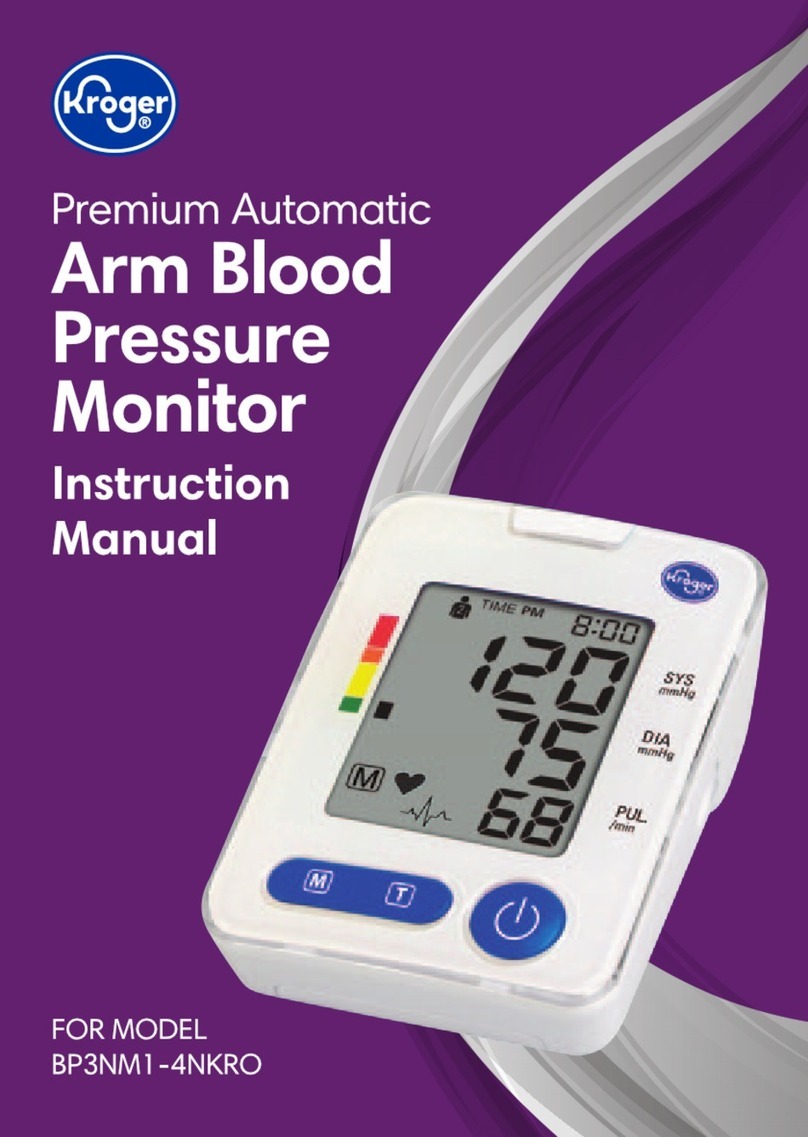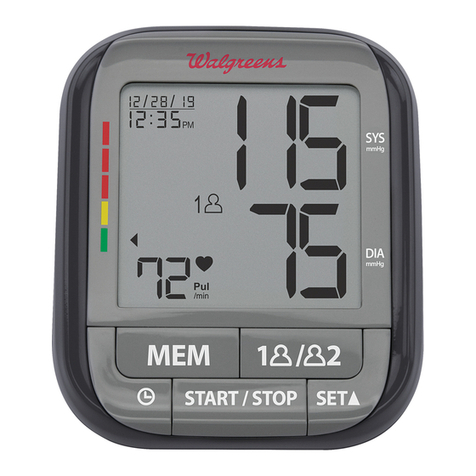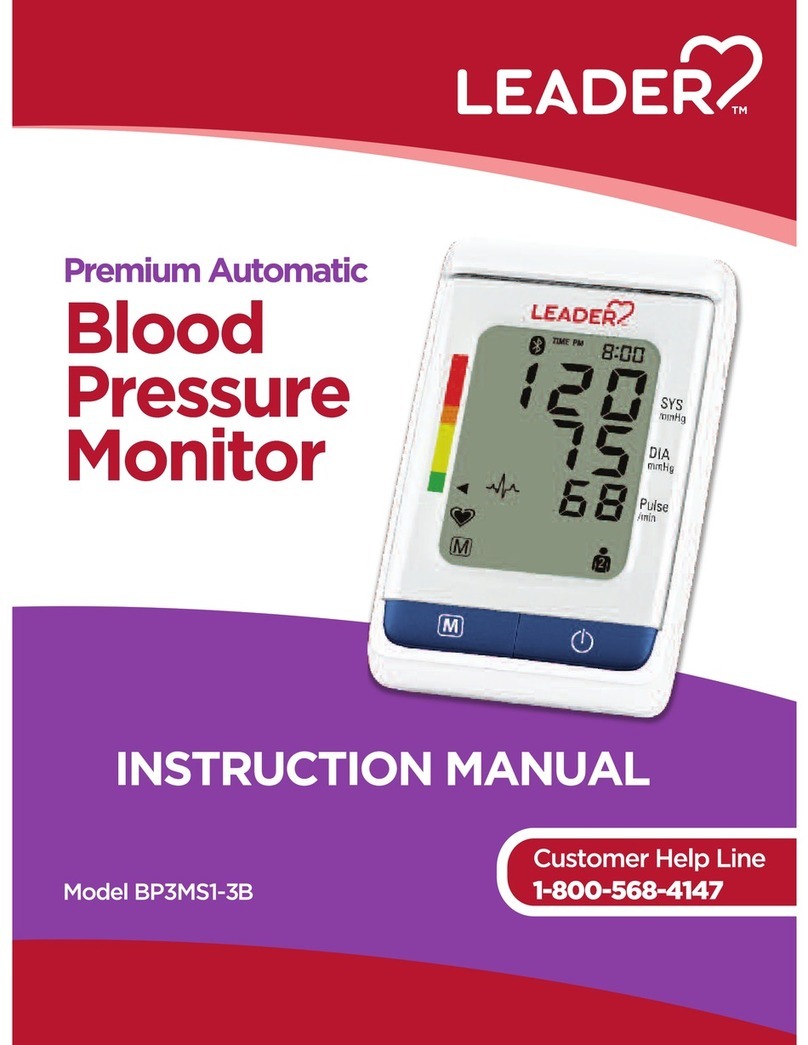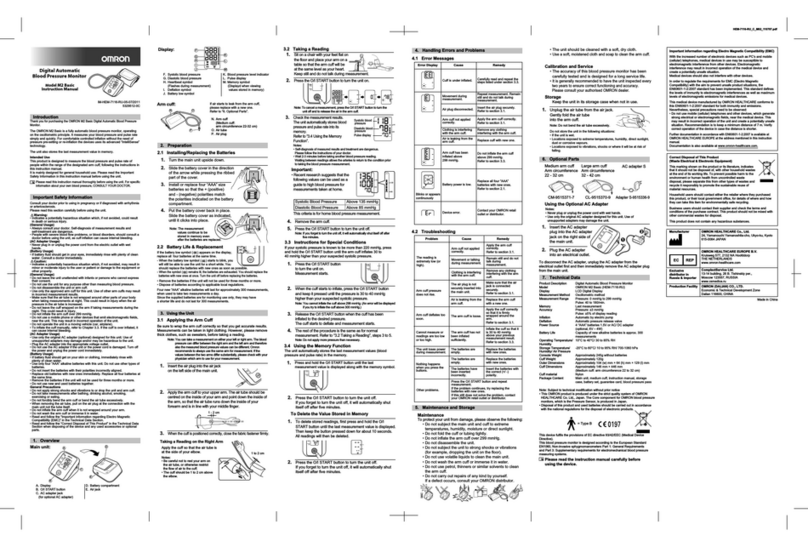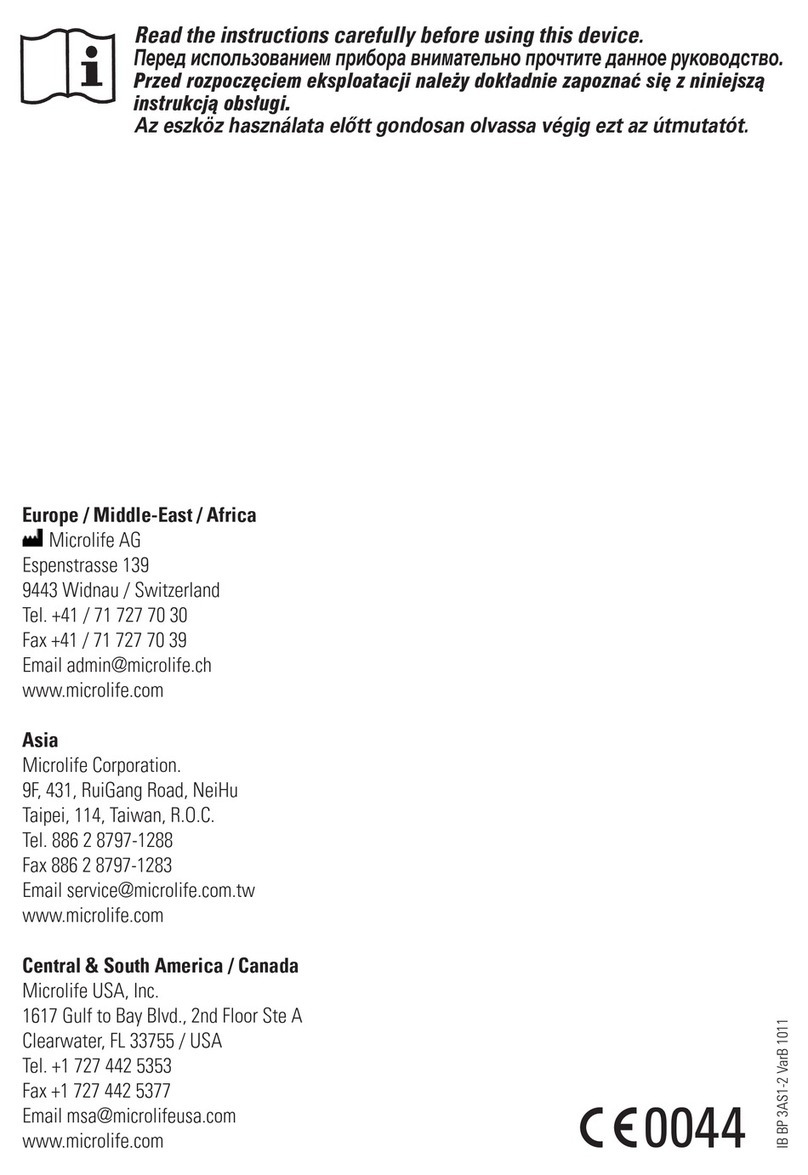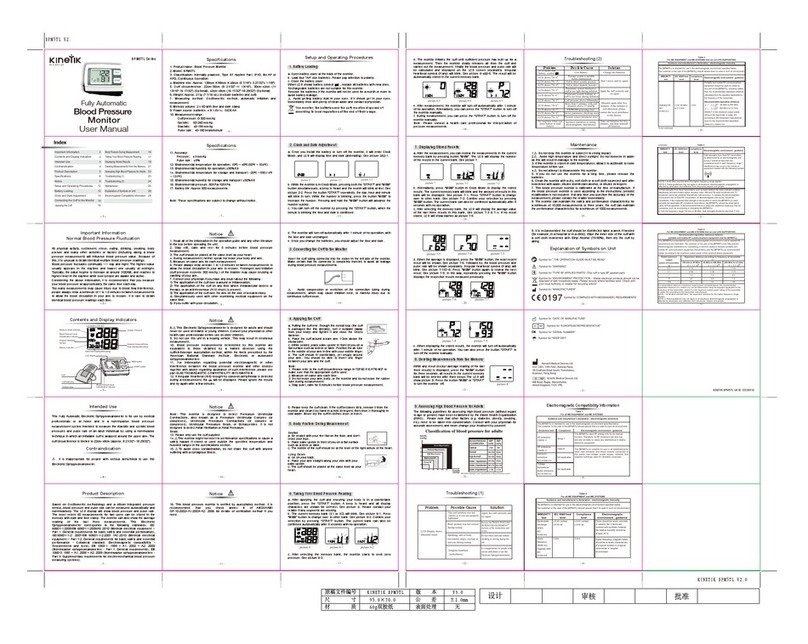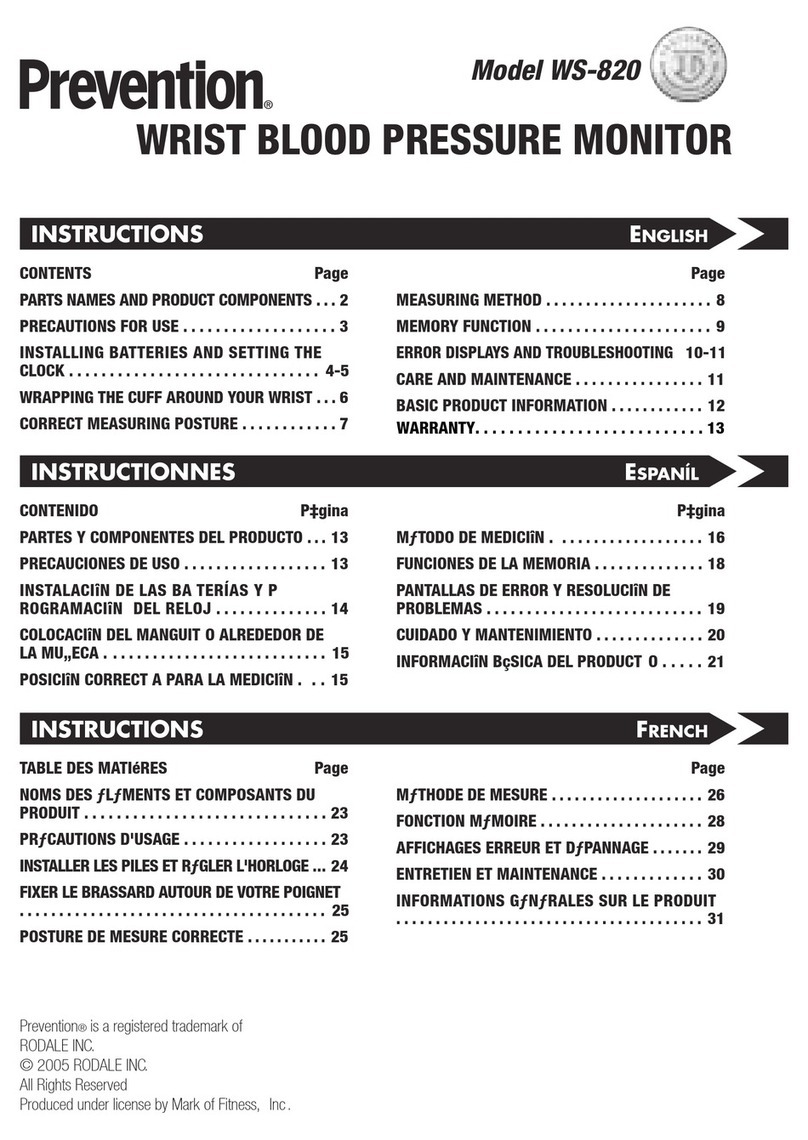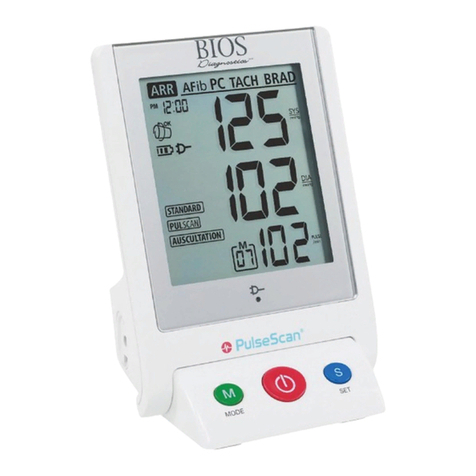Kroger BP3NP1-3EKRO User manual


Important Product and Safety Information
Follow Instructions for Use. This document provides important
product operation and safety information regarding this Blood
Pressure Monitor. Please read this document thoroughly before
using the device and keep for future reference.
This blood pressure monitor is an automatic digital blood pressure mea-
suring device for use by adults on the wrist at home or in the doctor’s
office. It enables a very fast and reliable measurement of the systolic and
diastolic blood pressure, as well as the pulse rate, by way of the oscillo-
metric method. This device detects the appearance of irregular heartbeats
during measurement and provides a warning signal when the irregular
heartbeat is detected.
This blood pressure monitor IS intended to be used:
•For self-measurement/monitoring of blood pressure and pulse in
adults; whereas the person being measured may be the user/operator
of the device.
•Within a home healthcare environment.
•With a cuff located upon the user’s wrist; ½inch from the hand.
This blood pressure monitor IS NOT intended for use with:
• Pregnancy
• Preeclampsia
•Children under 12
•Neonatal patients
WARNING – Potentially hazardous situation that if not
avoided may result in serious injury or death.
•Self-measuring means monitoring, not diagnosis or treatment. Unusual
values must always be discussed with your doctor. Under no circum-
stances should you independently alter the dosages of any drugs pre-
scribed by your physician.
1

•Consult your physician before using this device if any of the following
or similar conditions are present: arrhythmias such as atrial or ventricular
premature beats or atrial fibrillation, arterial sclerosis, poor perfusion
,
diabetes, age, pregnancy, preeclampsia, renal diseases. Motion during
measurement, including trembling or shivering may affect the mea-
surement.
•Though not for use with children under 12, ensure that any children
around this device are supervised; some parts are small enough to be
swallowed.
DO NOT:
Use this device if you think it is damaged or anything appears unusual
(e.g. sporadic operation, open packaging upon purchase).
Use the displayed pulse for checking the frequency of heart pacemakers
as this device is not suitable for this action.
Open/modify this device; inaccuracy and/or harmful injury may result.
Conduct many frequent measurements as this may result in harmful
injury due to blood flow interference.
Place the Cuff over a wound as this may cause further injury.
Place and pressurize the Cuff over/near any present intravascular
access or therapy, or arteriovenous shunt, as this may cause blood
flow interference and result in harmful injury.
Place and pressurize the Cuff over a limb near the side of a mastectomy
as this may cause harmful injury.
Use the Blood Pressure Monitor on a limb simultaneously with other
medical equipment on the same limb due to possible interference with
such medical equipment.
Maintain pressure in the Cuff applied to the limb for a prolonged
amount of time. Ensure that circulation in the limb is not impaired by
checking circulation if prolonged/repeated exposure to pressure
occurs.
2

Service the device when being used or when power is supplied. When
the device is not in use and power is removed, batteries may be
replaced by the user. No other parts/components are accessible.
CAUTION – Potentially hazardous situation that if not
avoided may result in minor/moderate injury, property dam-
age, and/or damage to the device
•This device contains sensitive electronics components. Avoid strong
electrical or electromagnetic fields in the direct vicinity of the device
(e.g., mobile telephones, microwave ovens). These can lead to temporary
impairment of the measuring accuracy. Move the device to another
loca
tion if interference is determined.
•When not using the Blood Pressure Monitor for extended lengths of
time, remove the batteries to avoid potential battery leakage and damage
to the monitor.
•When replacing the batteries, ensure all the batteries are replaced
simultaneously to avoid battery damage and potential damage to the
monitor. Microlife USA does not recommend using rechargeable batteries.
•To avoid inaccurate measurements and to lessen any discomfort from
Cuff pressure, ensure the Cuff is placed correctly on the limb and fits
correctly when snug (not tight), as indicated by markings with the Cuff.
•
Consult your physician in cases of frequent irregular heartbeat detections.
•This Risk Indicator feature is provided in order to help you understand
your potential blood pressure risk. However, this feature is neither a
diagnosis nor a substitute for a medical examination. It is important to
consult with your physician to determine your risk.
DO NOT:
Drop this device or expose it to strong vibrations; sensitive compo-
nents may be affected resulting in inaccuracies and/or operational
issues.
3

Use the Blood Pressure Monitor outside of its specified operation
temperature
and humidity rating, or if stored outside of its specified
storage temperature and humidity rating. Avoid storage in direct sunlight.
Use this device in a moving vehicle; inaccurate measurements may result.
Use third party accessories. Only use Microlife authorized accessories,
such as cuffs or AC adapters, as those not approved for use with the
device may provide inaccurate measurements, injury, and/or damage
the device.
STANDARDS
This medical device is compliant with:
•Medical device and non-invasive blood pressure monitor standards
IEC 60601-1, IEC 60601-1-2, IEC 60601-1-11, and AAMI/ANSI/IEC
80601-2-30, and
•Electromagnetic standards IEC 60601-1-2, along with FCC Part 15, and
•
Clinical Testing per standard ANSI/AAMI/ISO 81060-2:2013 was conducted
on blood pressure device using the same measurement technology.
Please note: According to international standards, your monitor should be
checked for accuracy every 2 years.
TYPE
IP20: Protected against solid foreign particles with a diameter of
more than 12.5 mm, no protection against water.
Keep Dry.
Type BF Applied Part
Expected Life
Monitor 5 Years
Cuff 2 Years
Batteries and electronic instruments must be disposed of in accordance
with the locally applicable regulations, not with domestic waste.
4

FCC
This device complies with part 15 of the FCC Rules. Operation is subject
to the following two conditions: (1) This device may not cause harmful
interference, and (2) this device must accept any interference received,
including interference that may cause undesired operation. Changes or
modifications to the product are not approved by Microlife USA and could
void the user's authority to operate the equipment under FCC jurisdiction.
This equipment has been verified to comply with the limits for a Class B
digital device, pursuant to part 15 of the FCC Rules. These limits are
designed to provide reasonable protection against harmful interference in
a residential installation. This equipment generates uses and can radiate
radio frequency energy and, if not used in accordance with the instruc-
tions, may cause harmful interference to radio communications. However,
there is no guarantee that interference will not occur in a particular
installation. If this equipment does cause harmful interference to radio or
television reception, which can be determined by turning the equipment
on and off, the user is encouraged to try to correct the interference by
increasing the distance between the product and the affected device; or if
applicable, reorientation the receiving antenna, or moving the product’s
power plug to another receptacle.
5

Wrist Blood Pressure Monitor
Instruction Manual
Table of contents
1. Introduction
1.1. Your Automatic Wrist Blood Pressure Monitor
1.2. Inflation Mode Technology
2. How is blood pressure measured?
2.1. What is blood pressure, and why does it fluctuate?
2.2. Measurement Guidelines
2.3. What can I do to change my blood pressure?
3. Components of your blood pressure monitor
4. How do I get started?
4.1. Inserting the batteries
4.2. Setting the date and time
5. How do I take a measurement?
5.1. Preparing to take a measurement
5.2. Common errors
5.3. Using the cuff
5.4. Selecting the user
5.5. Taking a measurement
5.6. Stopping a measurement
5.7. Irregular heartbeat detection
5.8. Hypertension risk indicator
5.9. Memory: Reviewing readings
5.10. Setting the medication reminder
6

6. Battery change indicator
7. Error messages/troubleshooting
8. Care and maintenance
9. Limited warranty
10. Technical specifications
11. How to contact us
7

1. Introduction
1.1. Your Automatic Wrist Blood Pressure Monitor
Thank you for purchasing a fully automatic wrist blood pressure monitor.
Your monitor is designed to provide fast and reliable digital readings of
your pulse, and systolic / diastolic blood pressure using the oscillometric
method on your wrist. It offers clinically proven accuracy and has been
designed to be user friendly.
Before using your blood pressure monitor, please read this instruction
manual carefully to ensure correct use. If you have additional questions
regarding blood pressure measurements please contact your doctor.
1.2. Inflation Mode Technology
Please note that this device employs our “Inflation Mode Technology.”
This means your blood pressure is measured while the wrist cuff is inflat-
ing, rather than first inflating to a peak pressure and then measuring dur-
ing a slow deflation process. This unique technology provides a faster,
more comfortable blood pressure reading for you.
If you have any questions about your blood pressure reading or monitor,
please call us at 1-800-568-4147.
2. How is blood pressure measured?
2.1. What is blood pressure, and why does it fluctuate?
Your level of blood pressure is determined in the circulatory center of the
brain and adjusts to a variety of situations through feedback from the ner-
vous system. To adjust blood pressure, the strength and frequency of the
heart (pulse), as well as the width of circulatory blood vessels is altered.
Blood vessel width is affected by way of fine muscles in the blood vessel
walls. Your level of arterial blood pressure changes periodically during
heart activity. During the "blood ejection" (Systole), the value is highest
(systolic blood pressure value). At the end of the heart’s "rest period"
8

(Diastole), pressure is lowest (diastolic blood pressure value). Your blood
pressure values must lie within certain normal ranges in order to prevent
particular diseases.
2.2. Measurement Guidelines
Blood pressure is very high if your systolic blood pressure is over 140
mmHg and/or your diastolic pressure is above 90 mmHg, while at rest.
In this case, please consult your doctor immediately. Long-term values at
this level endanger your health due to continual damage to the blood ves-
sels in your body.
Should the systolic blood pressure values lie between 130 mmHg and 139
mmHg and/or the diastolic blood pressure values lie between 80 mmHg
and 89 mmHg, consult your doctor. Regular self-checks will be necessary.
If you have blood pressure values that are too low (i.e., systolic values under
105 mmHg and/or diastolic values under 60 mmHg), consult your physician.
Even with normal blood pressure values, a regular self-check with your
blood pressure monitor is recommended. You can detect possible changes
in your values early and react appropriately.
If you are undergoing medical treatment to control your blood pressure,
keep a record of values along with time of day and date.
Show these values to your physician. Never use the results of your
measurements
to independently alter the medication prescribed by
your physician.
9

Which values are normal?
The following standards for assessing high blood pressure (in adults) have
been established by the American Heart Association (AHA) and American
College of Cardiology (ACC) in 2017.
Additional information
•This chart reflects a 2017 update to blood pressure standards.
•If your values are mostly normal under resting conditions but excep-
tionally high under conditions of physical or psychological stress, it is
possible that you are suffering from so-called "labile hypertension."
Consult your physician.
Category Systolic Diastolic
(mm Hg) (mm Hg)
Normal <120 and <80
Elevated 120-129 and <80
Hypertension
Stage 1 Hypertension 130-139 or 80-89
Stage 2 Hypertension 140-179 or 90-119
Hypertensive Crisis ≥180 or ≥120
10

2.3. What can I do to change my blood pressure?
a) Consult your physician.
b) Increased blood pressure values (various forms of hypertension) are
associated with considerable health risks over time. Arterial blood ves-
sels in your body are endangered due to constrictions caused by
deposits in the vessel walls (arteriosclerosis). A deficient supply of
blood to important organs (heart, brain, muscles) can result. Further-
more, the heart will become structurally damaged with increased
blood pressure values.
c) There are many different causes of high blood pressure. We differenti-
ate between the common primary (essential) hypertension and sec-
ondary hypertension. Secondary hypertension can be ascribed to spe-
cific organ malfunctions. Please consult your physician for information
about the possible origins of your own increased blood pressure val-
ues.
d) There are measures you can take to reduce and even prevent high
blood pressure. These measures must be permanent lifestyle changes.
1) Eating habits
•Strive for a normal weight corresponding to your age. See your doctor
for your ideal weight.
•Avoid excessive consumption of common salt.
•Avoid fatty foods.
2) Previous illnesses
•
Follow consistently any medical instructions for treating illness such as:
•Diabetes (diabetes mellitus)
•Fat metabolism disorder
• Gout
11

3) Habits
•Give up smoking completely.
•Drink only moderate amounts of alcohol.
•Restrict your caffeine consumption (e.g., coffee).
4) Your physical condition
• After a medical examination, and with your doctor’s approval
and direction; exercise.
•Choose sports which require stamina and avoid those which require
strength.
•Avoid reaching the limit of your performance.
•With previous illnesses and/or an age of over 40 years, please consult
your doctor before beginning your exercise routine. Speak with your
doctor regarding the type and extent of exercise that is appropriate for
you.
12

3. Components of your blood pressure monitor
The illustration shows your blood pressure monitor, consisting of:
Fits wrist size 13.5-19.5 cm (5.3"-7.7")
M
T
Universal Size
Wrist Cuff
Battery Cover
Time/Date Button
Memory Recall
Hypertension
Risk Indicator
ON/OFF/START
Button
User 1 & 2
Hypertension Bar
Battery Indicator
Irregular Heartbeat
Memory
Heartbeat
Date/Time
Systolic
Diastolic
Pulse
Alarm
13

4. How do I get started?
4.1. Inserting the batteries
After you have unpacked your device, insert the batteries. The battery
compartment is located on the underside of the device.
a) Remove the battery cover.
b) Insert the batteries (2 x size AAA 1.5 V), following the indicated polarity.
c) If the battery warning appears in the display, the batteries are
discharged and must be replaced with new ones.
Attention!
•Please use AAA Long-Life or Alkaline 1.5 V batteries and replace them
all at the same time.
4.2. Setting the date and time
1. After the new batteries are activated, the year
number flashes in the display. You can advance
the year by pressing the memory or "M" button.
To confirm and then set the month, press the time
or "T" button.
2. You can now set the month using the "M" button.
To confirm and then set the day, press the "T" button.
3. Please follow the instructions above to set the
day, hour and minutes.
4. Once you have set the last minute and pressed
the "T" button, the date and time are set and the
time is displayed.
5. If you want to change the date and time, press
and hold the "T" button down for approx. 3 sec-
onds until the year starts to flash. Now enter the
new values as described above.
Memory
Button
Time/Date
Button
14

5. How do I take a measurement?
Please note: You should always be seated before and during the
measurement.
5.1. Preparing to take a measurement
•Avoid eating, smoking as well as all forms of exertion directly before
your measurement. These factors influence the measurement result.
Relax by sitting in an armchair in a quiet atmosphere for about
5 minutes
before your measurement.
•Always measure on the same wrist (normally left).
•Compare readings at the same time of day, since your blood pressure
changes during the course of the day.
5.2. Common errors
Note:
Comparable blood pressure measurements always require the
same conditions. These are normally always quiet conditions.
•All efforts to support the arm can increase blood pressure. Make sure
you are in a comfortable, relaxed position and do not flex any of the
muscles in the measurement arm during the measurement. Use a
cushion for support if necessary.
•If the wrist artery lies considerably lower (higher) than the heart, an
erroneously higher (lower) blood pressure will be measured. (Each 15 cm/6"
difference in height results in a
measurement error of 10 mmHg.)
•
A loose cuff causes false measurement values
.
•With repeated measurements, blood can accumulate in the respective
arm, which can lead to false results. Correctly executed blood pressure
measurements should therefore first be repeated after a 1 minute
pause in order to allow the accumulated blood to flow away.
15

5.3. Using the cuff
a) Remove all objects and jewelry (e.g.,
wristwatch) from the wrist in use. This is
normally the left wrist. Put the cuff over
the wrist with the monitor face on the
inside of the wrist.
b) The distance between the cuff and the
hand should be approx. 10 mm (1/2").
c) Secure the cuff with the hook and loop
fastener so that it lies comfortably and not
too tight. No space should remain
between the cuff and the wrist.
d) Support the arm with the monitor case so
that the cuff rests at the same height as
the heart. Remain still for 5
mi
nutes before beginning the measurement.
0.5 - 1.0 cm
(¼” - ½”)
M
T
16

5.4. Selecting the user
With the unit powered off:
a) Press the TIME button to toggle between user 1 and
user 2.
b)
Press the MEMORY button to confirm your user selection.
5.5. Taking a measurement
After the cuff has been appropriately positioned the
measurement can begin.Remain still during your mea-
surement, do not flex muscles.
a) Remain seated quietly for 5 minutes before you
begin the measurement.
b) Press the POWER button to begin. After pressing
the POWER button you will hear a series of short
beeps and the pump begins to inflate the cuff. The
measurement is performed while cuff inflates. The
pumping speed can vary, which is completely nor-
mal. The increasing cuff pressure will show on the
display.
c) When the device has detected the pulse, the heart
symbol in the display begins to blink.
d) When the measurement has been concluded, air in
the cuff is released. The measured systolic and
diastolic blood pressure values as well as the pulse
are now displayed. (Pulse=number of heartbeats
each minute) Example (Fig.): Systolic 118, Diastolic
73, Pulse 75. The measurement results are dis-
played for about one minute.
Pulse Detected -
Unit measuring
17

5.6. Stopping a measurement
If it is necessary to interrupt a blood pressure measure-
ment for any reason (e.g., the patient feels unwell), the
ON/OFF button can be pressed at any time. The device
then immediately lowers the cuff pressure automatically
and enters into sleep mode.
5.7. Irregular heartbeat detection
This symbol indicates that certain pulse irregu-
larities were detected during the measurement. In this
case, the result may deviate from your normal basal blood
pressure – repeat the measurement. In most cases, this is
no cause for concern. However, if the symbol appears on
a regular basis (e.g., several times a week with measure-
ments taken daily), we advise you to tell your doctor.
Please show your doctor the following explanation:
Information for the doctor on frequent appearance of the
irregular heartbeat symbol
This instrument is an oscillometric blood pressure monitor device that
also analyzes pulse frequency during measurement. The instrument is
clinically tested.
If pulse irregularities occur during measurement, the irregular heartbeat
symbol is displayed after the measurement. If the symbol appears more
frequently (e.g., several times per week on measurements performed
daily) or if it suddenly appears more often than usual, we recommend the
patient to seek medical advice.
The instrument does not replace a cardiac examination but serves to
detect pulse irregularities at an early stage.
18

5.8. Hypertension risk indicator
The colored indicator on the left-hand edge of the display has been
designed to provide a quick visual representation of your blood pressure.
Once a measurement has been completed, a black bar will display
onscreen next to the colored hypertension indicator. The height of the
black bar will show if the measurement is within the normal (green), bor-
derline (yellow/orange) or danger (red) range.
This classification is based on standards established by the American
Heart Association (AHA) and American College of Cardiology (ACC) in 2017.
If the black bar is in the:
•green zone, your measurement is "Normal."
•lower yellow zone, it is "Elevated."
•upper yellow zone, it is "Stage 1 Hypertensive."
•orange zone, it is "Stage 2 Hypertensive.”
•lower red zone, it is "Stage 2 Hypertensive.”
•upper red zone, it is "Hypertensive Crisis."
Indication of a
"Normal"
Blood Pressure
Indication of
"Stage 1 Hyper-
tensive"
Indication of an
“Elevated”
Blood Pressure
Indication of a
"Stage 2 Hyper-
tensive"
Indication of a
"Hypertensive
Crisis"
Indication of a
"Stage 2 Hyper-
tensive"
M
T
19
Table of contents
Languages:
Other Kroger Blood Pressure Monitor manuals
